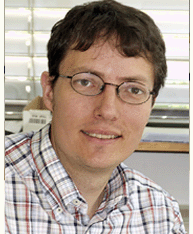
Georg Stoecklin
Group Leader in the
DKFZ-ZMBH Alliance
German Cancer Research Center
Im Neuenheimer Feld 280
69120 Heidelberg, Germany
Tel: +49-6221-546887
Fax: +49-6221-545891
Welcome to the Stoecklin Lab! Many genes are regulated at the posttranscriptional level by mechanisms that control the translation efficiency and degradation rate of the mRNA in the cytoplasm. Our main focus is a group of unstable mRNAs that contain AU-rich elements. We investigate how RNA-binding proteins regulate the stability of these mRNAs, and how their subcellular localization in processing bodies and stress granules affects translation and degradation rates. In addition, we search for tumors in which the regulation of mRNA stability is abnormal. Our principal model systems are macrophages and different mammalian cell lines. Specific topics of our research are: -> Cis-acting elements: The AU-rich element (ARE) is the most abundant regulatory element found in unstable mRNAs of eukaryotic organisms. Using RNA-immunoprecipitation techniques followed by microarray analysis, we are exploring the spectrum of mRNAs regulated by AREs. In addition, we are identifying and characterizing novel classes of non-ARE destabilizing elements. Cytoplasmic mRNA is routed to "stress granules" (blue) after translational silencing, and delivered to "processig bodies" (yellow) for degradation.
Posttransciptional Control of Gene Expression
-> Trans-acting factors: A family of zinc-finger proteins including TTP is required for the degradation ARE-containing cytokine mRNAs in macrophages and T-cells. Upon extracellular stimulation, decay of these mRNAs is inhibited to allow for a rapid increase in cytokine production. Phosphorylation of TTP is important for stabilizing cytokine mRNAs, and current projects are aimed at further understanding how TTP activity is regulated.
-> Subcellular organization of mRNA decay: 5' to 3' degradation of mRNAs occurs in specific cytoplasmic foci termed processing bodies. In response to stress, most mRNAs are translationally repressed and aggregate in different cytoplasmic structures termed stress granules. We further explore how cells control the trafficking of mRNA between ribosomes, processing bodies and stress granules. DKFZ & ZMBH Alliance: Our lab is a Helmholtz Junior Research Group of the German Cancer Research Center (DKFZ). As members of the DKFZ & ZMBH Alliance, we are happy to have guest status at the ZMBH and thereby further the scientific and personal interactions between the two institutes. You may also visit our website at the DKFZ.
Selected Publications
Stoecklin G, Tenenbaum SA, Mayo T, Chittur SV, George AD, Baroni TE, Blackshear PJ, Anderson P (2008) Genome-wide analysis identifies interleukin-10 mRNA as target of tristetraprolin. J Biol Chem 83:11689-99
Stoecklin G, Mayo T, Anderson P (2006) ARE-mRNA degradation requires the 5'-3' decay pathway. EMBO Rep 7:72-7.
Kedersha N, Stoecklin G, Ayodele M, Yacono P, Lykke-Andersen J, Fritzler MJ, Scheuner D, Kaufman RJ, Golan DE, Anderson P (2005) Stress granules and Processing Bodies are dynamically linked sites of mRNP remodeling. J Cell Biol 169:871-84.
Stoecklin G, Stubbs T, Kedersha N, Wax S, Rigby WFC, Blackwell TK, Anderson P. (2004) MK2-induced tristetraprolin:14-3-3 complexes prevent stress granule association and ARE-mRNA decay. EMBO J 23:1313-24.
Stoecklin G, Colombi M, Raineri I, Leuenberger S, Mallaun M, Schmidlin M, Gross B, Lu M, Kitamura T, Moroni C (2002) Functional cloning of BRF1, a regulator of ARE-dependent mRNA turnover. EMBO J 21:4709-18.
![]()
